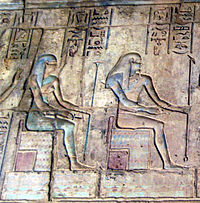Kek (mythology)
| Kekui in hieroglyphs | ||||||||||
|---|---|---|---|---|---|---|---|---|---|---|
Kek | ||||||||||
Kekui | ||||||||||
Kekuit | ||||||||||

| ||||||||||
Kek is the deification of the concept of primordial darkness (kkw sm3w[1]) in the ancient Egyptian Ogdoad cosmogony of Hermopolis.
The Ogdoad consisted of four pairs of deities, four male gods paired with their female counterparts. Kek's female counterpart was Kauket.[2][3][4] Kek and Kauket in some aspects also represent night and day, and were called "raiser up of the light" and the "raiser up of the night", respectively.[5]
The name is written as kk or kkwy with a variant of the sky hieroglyph in ligature with the staff (N2) associated with the word for "darkness" kkw.[6]
History[]
| Part of a series on |
| Ancient Egyptian religion |
|---|
 |
|
|
In the oldest representations, Kekui is given the head of a serpent, and Kekuit the head of either a frog or a cat. In one scene, they are identified with Ka and Kait; in this scene, Ka-Kekui has the head of a frog surmounted by a beetle and Kait-Kekuit has the head of a serpent surmounted by a disk.[7]
In the Greco-Roman period, Kek's male form was depicted as a frog-headed man, and the female form as a serpent-headed woman, as were all four dualistic concepts in the Ogdoad.
In popular culture[]
In relation to the 2016 United States presidential election, individuals associated with online message boards, such as 4chan, noted a similarity between Kek and the character Pepe the Frog. This, combined with the frequent use of the term "kek" as a popular stand-in for the internet slang "lol", which was often paired with images of Pepe, resulted in a resurgence of interest in the ancient deity.[8]
See also[]
References[]
- ^ Hornung, E. (1965). "Licht und Finsternis in der Vorstellungswelt Altägyptens". Studium Generale. 8: 72–83.
- ^ Budge, E. A. Wallis (1904a). The Gods of the Egyptians: Or, Studies in Egyptian Mythology. Vol. 1. Methuen & Co. pp. 241, 283–286.
- ^ Budge, E. A. Wallis (1904b). The Gods of the Egyptians: Or, Studies in Egyptian Mythology. Vol. 2. Methuen & Co. pp. 2, 378.
- ^ Steindorff, Georg (1905). The Religion of the Ancient Egyptians. G. P. Putnam's Sons. p. 50.
- ^ Budge (1904a), p. 285f, vol. 1.
- ^ Budge (1904a), p. 283, vol. 1.
- ^ Budge (1904a), p. 286, vol. 1.
- ^ David, Neiwert (May 8, 2017). "What the Kek: Explaining the Alt-Right 'Deity' Behind Their 'Meme Magic'". Southern Poverty Law Center. Retrieved September 14, 2017.
External links[]
- Seawright, Caroline (2003). "Kek and Kauket, Deities of Darkness, Obscurity and Night". Archived from the original on 2017-05-13. Retrieved 2012-09-25.
- Egyptian deities
- Creator deities
- Night deities
- Darkness
- Egyptian demons
- Legendary amphibians